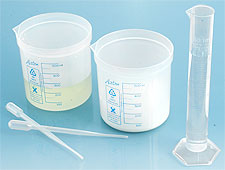Life Science Lab - Membranes
Recommended Grade Level: Middle School
the Video!
This is a great lab to demonstrate how certain molecules are small enough to cross through certain barriers while others are not. Using several simple supplies, this lab could be a great activity for your life sciences class, or a good science fair project. This lab demonstrates the porous nature of certain materials commonly found in nature.
Begin by gathering all of the materials needed to make this laboratory a success. You will need a plastic sandwich bag with either a zip top or a twist tie. Additionally, you will need iodine solution, cornstarch, (2) 500 ml beakers, a transfer pipette and one graduated cylinder. We recommend that you also use disposable lab safety gloves to prevent staining your hands with the iodine solution.
As always, be sure to monitor your students or children during any laboratory activity.

1. Measuring
Using your graduated cylinder, measure out 250 ml of water and fill one of your beakers with this water, then add about 20 drops of iodine. Next, fill your second beaker with 250 ml of water and stir in 15 ml (1 tablespoon) of cornstarch.

2. Adding to the Iodine Solution
Now pour one half of the starch and water mixture into the plastic bag. Either zip or tie the plastic bag shut. Place this bag into the beaker of water and iodine. Record immediate changes, if any, you see.
3. Check out the Results
Come back to check up on this solution after 30 minutes and record any new changes that you find. Discuss your results in either a lab report or as a class. Iodine is used in this lab to test for the presence of starch and will turn the starch and water mixture in the bag black. Iodine particles are small enough to move through the invisible holes in the plastic bag, but the starch molecules are too big to go anywhere!
4. Discuss Results
Discuss your results as a class. Did anyone find any differences among their results? If so, what might have accounted for these differences? Why is it that the iodine travels into the bag of cornstarch solution, but the cornstarch does not travel into the iodine solution? Explain that iodine is an indicator for starch, and starch should turn a blue-black color when in the presence of iodine.
By accessing this website, you agree not only to the Terms & Conditions set forth by SKS Science Products, but you also agree that SKS Science Products shall not be held liable for any of its users actions. Science experiment results may vary and should always be done with adult supervision.
 Plastic Beakers
Plastic Beakers Graduated Cylinder
Graduated Cylinder Transfer Pipettes
Transfer Pipettes